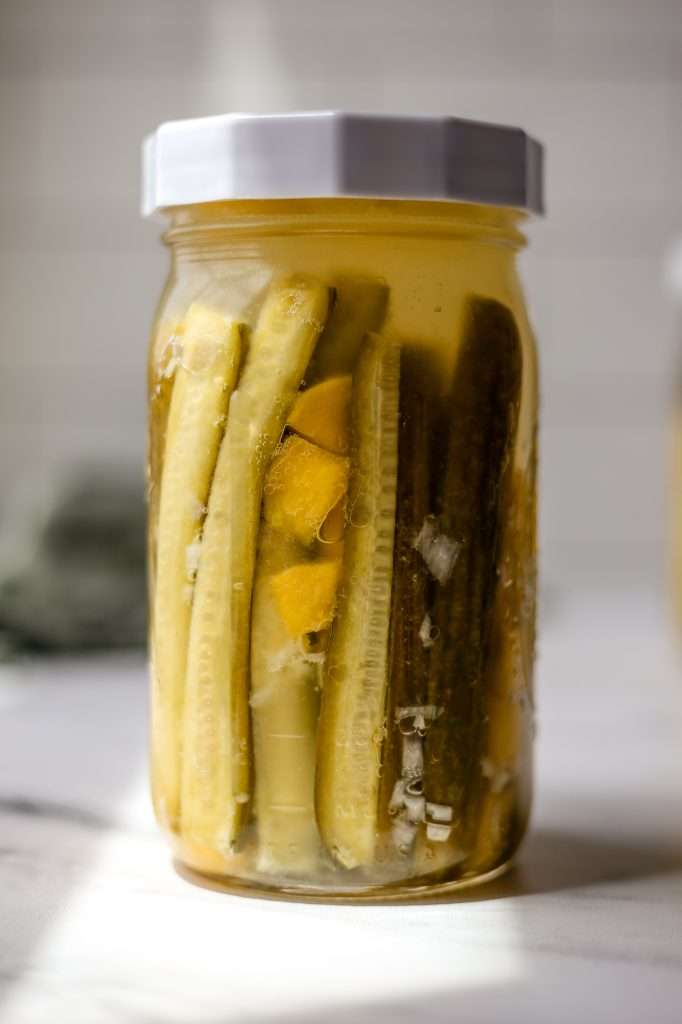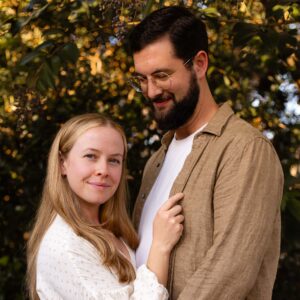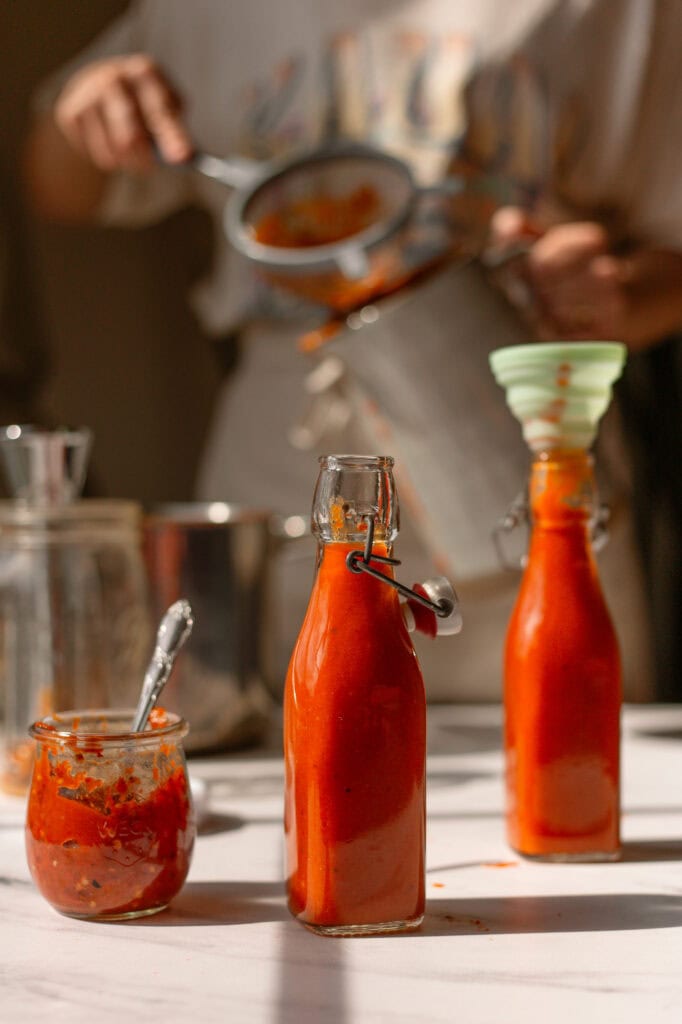Do Fermented Foods Have to Be in an Anaerobic Environment?
It depends on the fermented food or drink in question! Oxygen is a fermentation variable that can be manipulated to facilitate certain kinds of fermentation.
Fermented vegetables must be in an anaerobic (oxygen-free) environment. This environment is crucial because it allows beneficial bacteria to thrive and ferment while minimizing the growth of undesirable microorganisms.
For example, when making sauerkraut or kimchi, the vegetables are submerged under a brine. The brine excludes air, creating an anaerobic condition that facilitates the growth of lactic acid bacteria. These bacteria convert sugars into lactic acid, which acts as a preservative and gives fermented foods their distinctive sour flavor.
Anaerobic vs Aerobic Fermentation
The distinction between anaerobic and aerobic fermentation primarily revolves around the presence or absence of oxygen and the type of microorganisms involved—every fermentation results in different products and flavors.
Anaerobic Fermentation
Anaerobic fermentation occurs in the absence of oxygen. We use anaerobic fermentation to ferment dairy products, vegetables, and certain beverages.
Here’s how it works:
- Microorganisms Involved: Lactic acid bacteria (LAB) are the most common agents in anaerobic fermentation. These include species like Lactobacillus, Leuconostoc, and Pediococcus.
- Process: In anaerobic fermentation, the food is placed where oxygen is limited or absent, such as submerging vegetables in brine or sealing yogurt in an air-tight container. The LAB converts carbohydrates (such as sugars) in the food into lactic acid.
- Products and Benefits: The primary product of this process is lactic acid, which acts as a natural preservative by lowering the pH and creating an environment hostile to harmful bacteria. This method is used in making foods like sauerkraut, kimchi, and pickles. It enhances the food’s digestibility, shelf-life, and nutritional value.

Aerobic Fermentation
Aerobic fermentation requires oxygen and produces vinegar, kombucha, and some types of sourdough bread.
Here’s the breakdown:
- Microorganisms Involved: This type of fermentation is generally carried out by yeast and acetic acid bacteria. Yeasts first convert sugars into alcohol in a partially anaerobic step, and then acetic acid bacteria (like Acetobacter) convert the alcohol into acetic acid under aerobic conditions.
- Process: Aerobic fermentation requires exposure to air. For example, when making vinegar, the alcoholic liquid is exposed to air; acetic acid bacteria use oxygen to transform the alcohol into acetic acid.
- Products and Benefits: The primary product is acetic acid, which gives vinegar its distinctive, sharp flavor. We also use this process to cultivate beneficial bacterial colonies in foods like kombucha, where yeast (producing alcohol) and bacteria (producing acetic acid) play roles.
Key Differences
- Oxygen Requirement: Anaerobic fermentation occurs without oxygen, while aerobic fermentation requires oxygen.
- End Products: Anaerobic fermentation primarily produces lactic acid, whereas aerobic fermentation often results in acetic acid.
- Flavor Profiles: Anaerobic fermentation typically yields mild and tangy flavors, while aerobic fermentation can introduce sharper, more pungent tastes due to acetic acid and other byproducts.
Understanding these processes helps select the appropriate fermentation method based on the desired food product and its sensory and preservation attributes.

Keeping Fermented Vegetables Anaerobic
You do not keep the oxygen out of fermenting vegetables. Microbes below the brine do that for you!
You do not need a fancy airlock or an expensive lid that sucks air out of the jar. Some people say that airlocks for vegetable fermentation stop “kahm yeast.” That’s not true. As you’ll learn in the next section, yeast grow and thrive in anaerobic conditions too.
You need only submerge everything in the brine with a fermentation weight. The liquid brine is naturally anaerobic thanks to bacterial succession and the natural fermentation process. So, as long as everything stays below the brine, the fermenting vegetable matter will be in anaerobic conditions.
This is why I recommend a simple and effective fermentation jar set-up. You only need a jar, a glass weight, and a rust-proof lid. You can read all about the best jars for vegetable fermentation here.

Another Example: Anaerobic Alcohol Fermentation
Anaerobic alcohol fermentation occurs when yeasts convert sugars into alcohol and carbon dioxide without oxygen. It is the basic process used to produce alcoholic beverages like beer and wine. The key to preventing alcohol from turning into vinegar during this process is preventing exposure to oxygen. This is done with an airlock.
(Wild craft beer fermentation works a little differently and sometimes involve coolships and exposure to oxygen before being switched to anaerobic barrel fermentation.)

Preventing Alcohol from Turning into Vinegar
Turning alcohol into vinegar (acetic acid) involves a different process known as aerobic fermentation, which is driven by acetic acid bacteria, mainly from the genus Acetobacter. These bacteria require oxygen to convert ethanol into acetic acid.
Here are key measures alcohol fermenters use to prevent this transformation:
- Minimizing Oxygen Exposure: After the initial fermentation, it is crucial to minimize the wine or beer’s exposure to air. This includes practices like sealing fermentation vessels tightly and using airlocks that allow carbon dioxide to escape while preventing air from entering.
- Sulfite Addition: Winemakers often add sulfites to wine after fermentation. Sulfites help preserve the wine by inhibiting the growth of bacteria, including acetic acid bacteria, and by acting as antioxidants that reduce the wine’s exposure to oxygen.
- Proper Storage: Storing alcoholic beverages in conditions that limit oxygen exposure (e.g., in sealed bottles or kegs) helps prevent the oxidation processes that can lead to the formation of vinegar.
- Temperature Control: Keeping fermentation and storage temperatures controlled can inhibit the activity of acetic acid bacteria, as they tend to be less active at cooler temperatures.
By carefully managing these factors, producers can ensure that alcohol remains stable and does not turn into vinegar. This control is essential for maintaining the quality and flavor profiles of alcoholic beverages.
Summary; TLDR
- Oxygen is a fermentation variable that can be manipulated to facilitate certain kinds of fermentation.
- Lactic acid fermentation, the kind of fermentation that gives us fermented vegetables, is anaerobic (no oxygen).
- Acetic acid fermentation, the kind of fermentation that turns alcohol into vinegar, is aerobic (with oxygen).
- Alcohol fermentation is anaerobic.
- Fermented vegetables are kept anaerobic with a fermentation weight. The weight keeps everything submerged in the oxygen-free brine.
- Alcohol brewing is kept anaerobic with airlocking. Airlocks keep oxygen from the vessel so acetic acid bacteria cannot grow on the liquid-air interface.
Reference Materials
National Research Council (US) Panel on the Applications of Biotechnology to Traditional Fermented Foods.Washington (DC): National Academies Press (US); 1992.



















